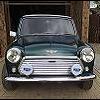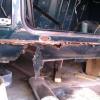Looking quite shiny now, so I'm guessing I have to G3 then G10 it for a proper finished shine?

When To Rub Down Laquer
#16

Posted 29 April 2009 - 11:31 AM
Looking quite shiny now, so I'm guessing I have to G3 then G10 it for a proper finished shine?
#17

Posted 29 April 2009 - 04:41 PM
Applied lacquer yesterday.... I think the back of the car, and the wings/front will be fine, still not convinced by rear wing area. Got to do bonnet and passenger door, but they'll follow next week.
Looking quite shiny now, so I'm guessing I have to G3 then G10 it for a proper finished shine?
That's looking really good! is that after flatting with sandpaper or is that how it went on?
#18

Posted 29 April 2009 - 04:43 PM
Hi Guys
I am about to aerosol my mini, on the subject of lacquer, do you let the paint dry then apply or do you apply whilst the paint is still wet?
Regards
David
Hi. You must let the paint coat dry for 24 hours at least. Then you can flat it with 1200 grit or finer wet and dry, using soapy water.
Once the panels are dry, then you apply the lacquer. Build it up in thin coats just like you did with the paint. If you are lucky you will get the lacquer to go on with a 'wet finish' which reduces the amount of flattint / cutting you need to do later. But don't wory about it if it goes on dull - you will be flatting it anyway.
Get a good few coats of lacquer on it, then let it dry for minimum 24 hours - 2-3 days is probably better. Then, as you did with the paint coat, flat it with 1200grit or finer wet and dry and soapy water. Once flat, bring it to a shine with rubbing compound, keeping the surface damp (not soaking) as you rub. If you have a polisher it will save you alot of time and arm pain at this stage!
Craig
Just wanted to say - I have raised a new thread basically asking the same thing... I know I told you to let the paint dry and then flat before applying lacquer, but a guy in a paint suppliers today told me to lacquer within 30 mins of the last coat of paint!
So just to be up front and let you know that I'm still waiting to see what others think.
Mind you, I have been doing it the way I described to you, and it seems to work fine.
#19

Posted 29 April 2009 - 06:41 PM
#20

Posted 29 April 2009 - 08:20 PM
You should never flat basecoat, unless you have debris in it, in which case it should be flatted out with 1000 grit and then recoated. You don't get roange peel with basecoat, it's very thin, if you get orange peel then you're applying it FAR too heavily. Never lacquer over flatted basecoat, it changes the colour and finish and you'll see scratches in certain lights. You should laquer after the basecoat has flashed off, which means when it has dried, gone matt. If you leave it too long, it hardens and the lacquer would flake off in time. I leave it about 5 minutes in a booth, I guess without a booth you'd be looking at about 30 mins at the most. I find the best way to tell if lacquer is ready to polish, is if you can mark it by pressing the tip of your fingernail onto it, then it's too soft and should be left longer.
Hmmm. Is it possible that these rules don't apply to spraying with cans? Spraying from cans on top of primer it takes about 4 to 5 thin coats to get a good solid colour without the primer showing through, so after 4 or 5 coats I certainly find that I do have orange peel, quite a bit in fact.
Also, if you apply lacquer straight onto the paint, how do you deal with the situation where you are not painting a complete panel - eg repairing a dent, or small rust hole, where you have most of the panel masked off - in this situation you get a line at the masking tape.
Thanks for all the info
Craig
#21

Posted 29 April 2009 - 10:55 PM
The picture i posted earlier is without any buffing, its about 1 hour after applying the coat.
I've ordered some G3 and G10 to get a good shine on.... hopefully i'm doing right?
#22

Posted 30 April 2009 - 07:02 AM
It says clearly on spray cans, Acrylic ones anyway, that you need to let the basecoat harden for at leat 24hrs before applying the lacquer.
The picture i posted earlier is without any buffing, its about 1 hour after applying the coat.
I've ordered some G3 and G10 to get a good shine on.... hopefully i'm doing right?
funnily enough, I was going to add that this morning as I saw it on the can. I'm not too worried about the risk of lacquer adhesion, as I've not found that a problem, I'm just concerned about changing the colour of the basecoat through flatting as I've heard that can happen.
Still don't see how you are supposed to do clearcoat straight on fresh basecoat without getting orange peel and masking lines under the lacquer. I'm wondering if maybe you need to 'blend' the basecoat into the rest of the panel, going a little further each coat (to avoid a line building up anywhere) and then go even further again when you apply the clearcoat. But I will definitely have orange peel in the basecoat, and I presume the lacquer will build on that, so I would need to put down alot of lacquer to be able to flat all the clearcoat orange peel later.
I'm hoping panelbeaterpeter will come back in to answer some of these questions as I'm hoping to do some more painting tonight, and I would like to do it right!
#23

Posted 30 April 2009 - 01:26 PM
It says clearly on spray cans, Acrylic ones anyway, that you need to let the basecoat harden for at leat 24hrs before applying the lacquer.
The picture i posted earlier is without any buffing, its about 1 hour after applying the coat.
I've ordered some G3 and G10 to get a good shine on.... hopefully i'm doing right?
funnily enough, I was going to add that this morning as I saw it on the can. I'm not too worried about the risk of lacquer adhesion, as I've not found that a problem, I'm just concerned about changing the colour of the basecoat through flatting as I've heard that can happen.
Still don't see how you are supposed to do clearcoat straight on fresh basecoat without getting orange peel and masking lines under the lacquer. I'm wondering if maybe you need to 'blend' the basecoat into the rest of the panel, going a little further each coat (to avoid a line building up anywhere) and then go even further again when you apply the clearcoat. But I will definitely have orange peel in the basecoat, and I presume the lacquer will build on that, so I would need to put down alot of lacquer to be able to flat all the clearcoat orange peel later.
I'm hoping panelbeaterpeter will come back in to answer some of these questions as I'm hoping to do some more painting tonight, and I would like to do it right!
BUMP - Panelbeaterpeter are you there? Please help..
#24

Posted 30 April 2009 - 01:48 PM
i also recommend painting the whole panel with basecoat then within 1 hour spray the laquer on.
#25

Posted 30 April 2009 - 03:05 PM
Also with rattle cans you will never get the same finish as with a proper spray gun and compressor, so you might probably get plenty of orange peel and also dimples where its spat from the can, with a spray gun you can alter spray patterns and paint flow to get the perfect finish, with rattle cans you cant do this.
Paul.
Edited by Pauly, 30 April 2009 - 03:07 PM.
#26

Posted 30 April 2009 - 04:35 PM
I would mask off the area on a panel for primer because you need to flat it down anyway so it will get rid of the masking line, then for the colour coat you shouldn't mask the area and let the paint feather in, ive done this with my roof in one corner and you cant see it, I got overspray but nothing a good compounding didn't sort.
Also with rattle cans you will never get the same finish as with a proper spray gun and compressor, so you might probably get plenty of orange peel and also dimples where its spat from the can, with a spray gun you can alter spray patterns and paint flow to get the perfect finish, with rattle cans you cant do this.
Paul.
Hi, thanks for the info. Just to confirm - understand what you mean about the primer, so for the colour are you saying try to paint the main target area, but with each coat go a little further out (to avoid building up a line), then go a bit further again with the lacquer ?
I had been thinking today that that must be how you do it. Guess that means I would need to key the panel right up to just a bit further than I plan to take the lacquer coat?
Cheers
Craig
#27

Posted 30 April 2009 - 06:01 PM
#28

Posted 30 April 2009 - 08:55 PM
in my experiance the only way for a novice to paint basecoat is to flat off all the laquer on a panel and spray the whole panel with laquer.
i also recommend painting the whole panel with basecoat then within 1 hour spray the laquer on.
Thanks for the advice, starting to make sense now I think.
I think I will do as you say - flat the whole panel, basecoat the repair area and a bit beyond, trying to blend, then lacquer the whole panel.
What grit would I use for that? 600, 1200 etc? wet or dry?
#29

Posted 30 April 2009 - 09:13 PM
#30

Posted 01 May 2009 - 08:35 AM
So long as the old paint is in good condition I'd use grey scotchbrite, if it has any chips etc, then flat those out with 500 grit and then 800 prior to basecoat.
Thanks for that. Just wondering - whats the difference between the scotch brites? We have green at work which I could nick!! tried looking on the web, but can't find anything which explains how rough / fine each one is.
Can someone clear this up for me? Also, for interest, is it possible to relate the scotch brite pads to an equivalent or nearly equivalent grit of sandpaper?
0 user(s) are reading this topic
0 members, 0 guests, 0 anonymous users
















